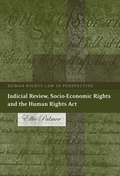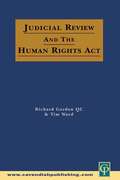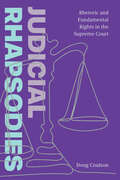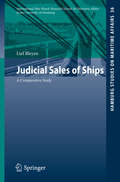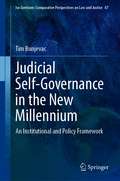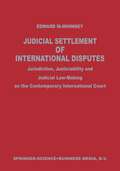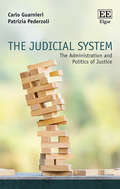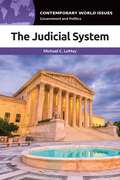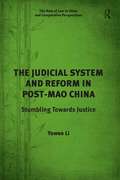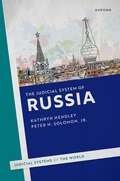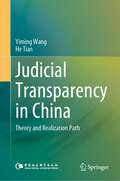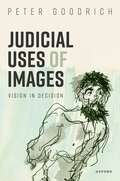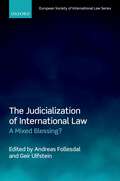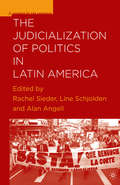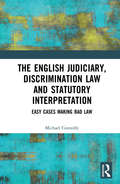- Table View
- List View
Judicial Review of National Security (Terrorism and Global Justice Series)
by David SchariaIn recent years, countries around the world introduced numerous national security programs and military campaigns. Despite the complex legal questions they raise, very few of these measures have been the subject of rigorous judicial review. Nevertheless, the absence of real-time review has had an enormous effect on human rights, rule of law, and on national security. The Supreme Court of Israel provides an excellent case study of a different approach, which allows judges to assess military action in real-time and to issue non-binding results of their evaluation. This raises the question: How was the Court actually able to uphold this challenge? In Judicial Review of National Security, David Scharia explains how the Supreme Court of Israel developed unconventional judicial review tools and practices that allowed it to provide judicial guidance to the Executive in real-time. In this book, he argues that courts could play a much more dominant role in reviewing national security, and demonstrates the importance of intensive real-time inter-branch dialogue with the Executive, as a tool used by the Israeli Court to provide such review. This book aims to show that if one Supreme Court was able to provide rigorous judicial review of national security in real-time, then we should reconsider the conventional wisdom regarding the limits of judicial review of national security.
Judicial Review, Socio-Economic Rights and the Human Rights Act (Human Rights Law in Perspective)
by Ellie PalmerIn the United Kingdom during the past decade, individuals and groups have increasingly tested the extent to which principles of English administrative law can be used to gain entitlements to health and welfare services and priority for the needs of vulnerable and disadvantaged groups. One of the primary purposes of this book is to demonstrate the extent to which established boundaries of judicial intervention in socio-economic disputes have been altered by the extension of judicial powers in sections 3 and 6 of the Human Rights Act 1998, and through the development of a jurisprudence of positive obligations in the European Convention on Human Rights 1950. Thus, the substantive focus of the book is on developments in the constitutional law of the United Kingdom. However, the book also addresses key issues of theoretical human rights, international and comparative constitutional law. Issues of justiciability in English administrative law have therefore been explored against a background of two factors: a growing acceptance of the need for balance in the protection in modern constitutional arrangements afforded to civil and political rights on the one hand and socio-economic rights on the other hand; and controversy as to whether courts could make a more effective contribution to the protection of socio-economic rights with the assistance of appropriately tailored constitutional provisions.
Judicial Review & the Human Rights Act
by Richard Gordon Tim WardThe Human Rights Act 1998 had a profound effect on the law of the United Kingdom,and in no area more so than judicial review. This book gives practical guidance on the interplay between the Act and domestic public law.
Judicial Review & the Human Rights Act
by Richard Gordon Tim WardThe Human Rights Act 1998 had a profound effect on the law of the United Kingdom,and in no area more so than judicial review. This book gives practical guidance on the interplay between the Act and domestic public law.
Judicial Rhapsodies: Rhetoric and Fundamental Rights in the Supreme Court
by Doug CoulsonAll judges legitimize their decisions in writing, but US Supreme Court justices depend on public acceptance to a unique degree. Previous studies of judicial opinions have explored rhetorical strategies that produce legitimacy, but none have examined the laudatory, even operatic, forms of writing Supreme Court justices have used to justify fundamental rights decisions. Doug Coulson demonstrates that such “judicial rhapsodies” are not an aberration but a central feature of judicial discourse. First examining the classical origins of divisions between law and rhetoric, Coulson tracks what he calls an epideictic register—highly affective forms of expression that utilize hyperbole, amplification, and vocabularies of praise—through a surprising number of landmark Supreme Court opinions. Judicial Rhapsodies recovers and revalues these instances as significant to establishing and maintaining shared perspectives that form the basis for common experience and cooperation.
Judicial Rhapsodies: Rhetoric and Fundamental Rights in the Supreme Court
by Doug CoulsonAll judges legitimize their decisions in writing, but US Supreme Court justices depend on public acceptance to a unique degree. Previous studies of judicial opinions have explored rhetorical strategies that produce legitimacy, but none have examined the laudatory, even operatic, forms of writing Supreme Court justices have used to justify fundamental rights decisions. Doug Coulson demonstrates that such “judicial rhapsodies” are not an aberration but a central feature of judicial discourse. First examining the classical origins of divisions between law and rhetoric, Coulson tracks what he calls an epideictic register—highly affective forms of expression that utilize hyperbole, amplification, and vocabularies of praise—through a surprising number of landmark Supreme Court opinions. Judicial Rhapsodies recovers and revalues these instances as significant to establishing and maintaining shared perspectives that form the basis for common experience and cooperation. “Judicial Rhapsodies is both compelling and important. Coulson brings his well-developed knowledge of rhetoric to bear on one of the most central (and most democratically fraught) means of governance in the United States: the Supreme Court opinion. He demonstrates that the epideictic, far from being a dispensable or detestable element of judicial rhetoric, is an essential feature of how the Court operates and seeks to persuade.” —Keith Bybee, Syracuse University
Judicial Sales of Ships: A Comparative Study (Hamburg Studies on Maritime Affairs #36)
by Lief BleyenThis work focuses on a specific aspect of the enforcement of maritime claims, namely judicial sales of ships, a procedure creditors typically resort to in the event of an irreversible default situation. A substantial part of the book approaches the topic from a comparative perspective, the goal being to assess the similarities and differences of the judicial sale procedure between three specific jurisdictions: Belgium, the Netherlands, and England & Wales. In this study, the comparison is used to further analyse the impacts of these differences on the effectiveness and reliability of the judicial sale procedure in each jurisdiction and also forms the basis for assessing the feasibility of harmonising judicial sale procedures and fostering their acceptance. Considering the international character typical of judicial sales of ships, conflict-of-law questions are very likely to arise during these procedures. Accordingly, the comparative study, where appropriate, is viewed against a private international law background.
Judicial Self-Governance in the New Millennium: An Institutional and Policy Framework (Ius Gentium: Comparative Perspectives on Law and Justice #87)
by Tim BunjevacThis book is a comparative study of judge-managed court systems across Australia, Europe and North America. This book makes an original contribution to the literature of court administration by providing a framework for examining court-service models of judicial councils, the policymaking bodies of courts and tribunals. This book promises to assist court administration scholars, judicial leaders, and policymakers in devising more effective organizational solutions to the contemporary challenges of judicial self-governance. The author Dr. Tim Bunjevac offers a nuanced elaboration of judicial accountability in court administration and a model institutional framework of court governance, comparing key Australian and international models of court administration, including the Australian Federal and two state court systems, Irish, English, Canadian and Dutch models. With a close case study, the author puts his sharpest focus on the Victoria, Australia, which introduced a judicial council in 2014. This book does an innovative job of proposing a new elaboration of judicial accountability in court administration. This book proposes that the likely success of any court system reform ultimately depends on the quality of the interaction between the courts, government, and other justice system stakeholders, which must be rooted in the concepts of organizational transparency and administrative accountability.
Judicial Settlement of International Disputes: Jurisdiction, Justiciability and Judicial Law-Making on the Contemporary International Court
by Edward J. McWhinneyThe Judicial System: The Administration and Politics of Justice
by Carlo Guarnieri Patrizia PederzoliExploring the growing significance of the administration of justice in both democratic and non-democratic countries, often labeled as ‘the judicialization of politics’, this timely book considers how increased levels of interest in the analysis of judicial institutions have been triggered. It examines the expansion of the role of judges and courts in the political system and the mixed reactions generated by these developments. In this comprehensive book, Carlo Guarnieri and Patrizia Pederzoli draw on a wealth of experience in teaching and research in the field, moving beyond traditional legal analysis and providing a clear, concise and all-encompassing introduction to the phenomenon of the administration of justice and all of its traits. Facilitating a deeper understanding of the concrete dynamics characterizing the judicial system and its relationships with the political environment, it also offers a balanced assessment of the process of judicialization. Students and scholars interested in comparative law and politics, and law and society, who wish to broaden their understanding of courts and the operation of the judicial system will find this to be a valuable resource. The wide coverage of cases from both common and civil law traditions will also appeal to practitioners.
The Judicial System: A Reference Handbook (Contemporary World Issues)
by Michael C. LeMayThe Judicial System: A Reference Handbook provides an authoritative and accessible one-stop resource for understanding the U.S. judicial system and its place in the fabric of American government and society.The American judicial system plays a central role in setting and enforcing the legal rules under which the people of the United States live. U.S. courts and laws, though, are complex and often criticized for bias and other alleged shortcomings, The U.S. Supreme Court has emerged as a particular focal point of political partisanship and controversy, both in terms of the legal decisions it hands down and the makeup of its membership.Like other books in the Contemporary World Issues series, this volume comprises seven chapters. Chapter 1 presents the origins, development, and current characteristics of the American judicial system. Chapter 2 discusses problems and controversies orbiting around the U.S. justice system today. Chapter 3 features a wide-ranging collection of essays that examine and illuminate various aspects of the judicial system. Chapter 4 profiles influential organizations and people related to the justice system, and Chapter 5 offers relevant data and documents about U.S. courts. Chapter 6 is composed of an annotated list of important resources, while Chapter 7 offers a useful chronology of events.
The Judicial System: A Reference Handbook (Contemporary World Issues)
by Michael C. LeMayThe Judicial System: A Reference Handbook provides an authoritative and accessible one-stop resource for understanding the U.S. judicial system and its place in the fabric of American government and society.The American judicial system plays a central role in setting and enforcing the legal rules under which the people of the United States live. U.S. courts and laws, though, are complex and often criticized for bias and other alleged shortcomings, The U.S. Supreme Court has emerged as a particular focal point of political partisanship and controversy, both in terms of the legal decisions it hands down and the makeup of its membership.Like other books in the Contemporary World Issues series, this volume comprises seven chapters. Chapter 1 presents the origins, development, and current characteristics of the American judicial system. Chapter 2 discusses problems and controversies orbiting around the U.S. justice system today. Chapter 3 features a wide-ranging collection of essays that examine and illuminate various aspects of the judicial system. Chapter 4 profiles influential organizations and people related to the justice system, and Chapter 5 offers relevant data and documents about U.S. courts. Chapter 6 is composed of an annotated list of important resources, while Chapter 7 offers a useful chronology of events.
The Judicial System and Reform in Post-Mao China: Stumbling Towards Justice (The Rule of Law in China and Comparative Perspectives)
by Yuwen LiThis comprehensive study examines the development and changing characteristics of the judicial system and reform process over the past three decades in China. As the role of courts in society has increased so too has the amount of public complaints about the judiciary. At the same time, political control over the judiciary has retained its tight-grip. The shortcomings of the contemporary system, such as institutional deficiencies, shocking cases of injustice and cases of serious judicial corruption, are deemed quite appalling by an international audience. Using a combination of traditional modes of legal analysis, case studies, and empirical research, this study reflects upon the complex progress that China has made, and continues to make, towards the modernisation of its judicial system. Li offers a better understanding on how the judicial system has transformed and what challenges lay ahead for further enhancement. This book is unique in providing both the breadth of coverage and yet the substantive details of the most fundamental as well as controversial subjects concerning the operation of the courts in China.
The Judicial System and Reform in Post-Mao China: Stumbling Towards Justice (The Rule of Law in China and Comparative Perspectives #1)
by Yuwen LiThis comprehensive study examines the development and changing characteristics of the judicial system and reform process over the past three decades in China. As the role of courts in society has increased so too has the amount of public complaints about the judiciary. At the same time, political control over the judiciary has retained its tight-grip. The shortcomings of the contemporary system, such as institutional deficiencies, shocking cases of injustice and cases of serious judicial corruption, are deemed quite appalling by an international audience. Using a combination of traditional modes of legal analysis, case studies, and empirical research, this study reflects upon the complex progress that China has made, and continues to make, towards the modernisation of its judicial system. Li offers a better understanding on how the judicial system has transformed and what challenges lay ahead for further enhancement. This book is unique in providing both the breadth of coverage and yet the substantive details of the most fundamental as well as controversial subjects concerning the operation of the courts in China.
The Judicial System of Russia (Judicial Systems of the World)
by Prof Kathryn Hendley Prof Peter H. Solomon, Jr.The Judicial System of Russia paints a portrait of the courts of the Russian Federation under Putin, how they work in practice, and what shapes the behaviour of its judges. It stresses the dual nature of a judicial system, where ordinary cases are for the most part handled fairly, but where cases of interest to powerful persons are subject to influence—a common situation in authoritarian states. In so doing, the authors trace the origins of some contemporary practices to the Soviet past, but also identify novelties. They pay close attention to the struggles of reformers to make the courts fairer and more efficient, along with the measures taken to ensure that judges conform to the expectations of their political masters. This means dealing with the evolution of judicial governance, including the selection, promotion, and disciplining of judges. In studying the actual operation of the courts, the authors take a socio-legal approach, emphasizing how different players (petitioners, respondents, lawyers, prosecutors, accused, judges) behave and why. This means dealing with the full gamut of courts from justices of the peace through the Supreme and Constitutional Courts and analysing their conduct in ordinary civil disputes, criminal cases, business disputes, administrative justice (claims against state officials), and constitutional matters. The authors also examine the relation of the public to the courts, including its readiness to litigate disputes despite generally negative views of the courts. This analysis of the administration of justice in Russia covers both the Constitutional Amendments of 2020 and developments relating to the first months of the 2022 War in Ukraine. It is a must read for academics, practitioners, and all those with an interest in comparative courts and Russia's judicial system.
The Judicial System of Russia (Judicial Systems of the World)
by Prof Kathryn Hendley Prof Peter H. Solomon, Jr.The Judicial System of Russia paints a portrait of the courts of the Russian Federation under Putin, how they work in practice, and what shapes the behaviour of its judges. It stresses the dual nature of a judicial system, where ordinary cases are for the most part handled fairly, but where cases of interest to powerful persons are subject to influence—a common situation in authoritarian states. In so doing, the authors trace the origins of some contemporary practices to the Soviet past, but also identify novelties. They pay close attention to the struggles of reformers to make the courts fairer and more efficient, along with the measures taken to ensure that judges conform to the expectations of their political masters. This means dealing with the evolution of judicial governance, including the selection, promotion, and disciplining of judges. In studying the actual operation of the courts, the authors take a socio-legal approach, emphasizing how different players (petitioners, respondents, lawyers, prosecutors, accused, judges) behave and why. This means dealing with the full gamut of courts from justices of the peace through the Supreme and Constitutional Courts and analysing their conduct in ordinary civil disputes, criminal cases, business disputes, administrative justice (claims against state officials), and constitutional matters. The authors also examine the relation of the public to the courts, including its readiness to litigate disputes despite generally negative views of the courts. This analysis of the administration of justice in Russia covers both the Constitutional Amendments of 2020 and developments relating to the first months of the 2022 War in Ukraine. It is a must read for academics, practitioners, and all those with an interest in comparative courts and Russia's judicial system.
Judicial Transparency in China: Theory and Realization Path
by Yiming Wang He TianBased on the Judicial Transparency Index Assessment (2019 and 2020) conducted in China by the Institute of Law of the Chinese Academy of Social Sciences, this book summarizes and analyzes the current situation of judicial openness in China, using a sample of 218 courts across the country for the study. The book analyzes the ideological and institutional origins of judicial openness and examines the operation of judicial openness through the practical experience of role replacement. By analyzing evaluation data in the fields of audit information disclosure, trial information disclosure, judicial enforcement data disclosure, and judicial reform data disclosure, the book points out that the current judicial disclosure has made significant progress, but there are still problems such as unclear disclosure standards, insufficient rigidity in disclosure requirements, and the scope of disclosure still needs to be expanded. The book recommends accelerating the disclosure of judicial legislation, public standards, and strengthening assessment and accountability.
Judicial Uses of Images: Vision in Decision (Law and Literature)
by Prof Peter GoodrichA judge springs out of his car on the way to court in downtown Chicago and takes photographs of an inflatable rat. A while later he inserts these photographs into a decision involving another insufflated rodent used in a union protest. The increasing use of images in case law and precedent in the common law world provides a novel visual atlas of how lawyers see. Using a corpus of many images drawn from decisions in different common law jurisdictions across the globe, Judicial Uses of Images catalogues, analyzes, and reviews the normative significance and affective force of this new medium of legal expression and judgement. The remediation of law is critically dissected in the terms of the emergent optical criteria and protocols of retinal justice. .
Judicial Uses of Images: Vision in Decision (Law and Literature)
by Prof Peter GoodrichA judge springs out of his car on the way to court in downtown Chicago and takes photographs of an inflatable rat. A while later he inserts these photographs into a decision involving another insufflated rodent used in a union protest. The increasing use of images in case law and precedent in the common law world provides a novel visual atlas of how lawyers see. Using a corpus of many images drawn from decisions in different common law jurisdictions across the globe, Judicial Uses of Images catalogues, analyzes, and reviews the normative significance and affective force of this new medium of legal expression and judgement. The remediation of law is critically dissected in the terms of the emergent optical criteria and protocols of retinal justice. .
The Judicialization of International Law: A Mixed Blessing? (European Society of International Law)
by Geir Ulfstein Andreas FollesdalThe influence of international courts is ubiquitous, covering areas from the law of the sea to international criminal law. This judicialization of international law is often lauded for bringing effective global governance, upholding the rule of law, and protecting the right of individuals. Yet at what point does the omnipresence of the international judiciary shackle national sovereign freedom? And can the lack of political accountability be justified? Follesdal and Ulfstein bring together the crème de la crème of the legal academic world to ask the big questions for the international judiciary: whether they are there for mere dispute settlement or to set precedent, and how far they can enforce international obligations without impacting on democratic self-determination.
The Judicialization of International Law: A Mixed Blessing? (European Society of International Law)
The influence of international courts is ubiquitous, covering areas from the law of the sea to international criminal law. This judicialization of international law is often lauded for bringing effective global governance, upholding the rule of law, and protecting the right of individuals. Yet at what point does the omnipresence of the international judiciary shackle national sovereign freedom? And can the lack of political accountability be justified? Follesdal and Ulfstein bring together the crème de la crème of the legal academic world to ask the big questions for the international judiciary: whether they are there for mere dispute settlement or to set precedent, and how far they can enforce international obligations without impacting on democratic self-determination.
The Judicialization of Politics in Latin America (Studies of the Americas)
by Rachel Sieder L. Schjolden A. AngellDuring the last two decades the judiciary has come to play an increasingly important political role in Latin America. Constitutional courts and supreme courts are more active in counterbalancing executive and legislative power than ever before. At the same time, the lack of effective citizenship rights has prompted ordinary people to press their claims and secure their rights through the courts. This collection of essays analyzes the diverse manifestations of the judicialization of politics in contemporary Latin America, assessing their positive and negative consequences for state-society relations, the rule of law, and democratic governance in the region. With individual chapters exploring Argentina, Brazil, Chile, Colombia, Costa Rica, Mexico, Peru and Venezuela, it advances a comparative framework for thinking about the nature of the judicialization of politics within contemporary Latin American democracies.
Judicially Crafted Property Rights in Valuable Intangibles: An Analysis of the INS Doctrine
by Apostolos G. ChronopoulosApostolos G. Chronopoulos examines the doctrine of misappropriation offering a comprehensive and critical review of the relevant case law that takes into consideration the rich academic commentary on the topic.In the INS case, the Supreme Court held that a news agency may enjoin third parties from copying its news stories while these are still ‘fresh’. Chronopoulos seeks to clarify the heavily debated doctrinal issues that have since arisen as to: the exact legal nature of the recognized entitlement; whether the Supreme Court sought to establish a principle of general application; and the extent to which state claims to protect valuable intangibles under a common-law theory of liability survive federal preemption. Chronopoulos argues that the protection offered at state level should not be confined to the availability of a narrow tort of unfair competition protecting highly time-sensitive subject matter against parasitic appropriation by direct competitors; rather, the application of the misappropriation doctrine is bound to generate judge-made property rights in intangibles with time value.This book is an indispensable resource for academics who would have an interest in reexploring and revisiting the topic from a doctrinal perspective. Practitioners would also find the book’s theoretical groundwork useful.
The Judiciary, Discrimination Law and Statutory Interpretation: Easy Cases Making Bad Law
by Michael ConnollyIn 1856, the US Supreme Court denied Dred Scott, now free of slavery, his Constitutional rights, solely because he was black. According to the Court, when the Constitution was drafted, some 60 years earlier, its authors would not have intended that ‘a subordinate and inferior class of beings’ qualified as citizens of the United States. Thus, the meaning of language drafted over half a century before was frozen in time. This case, perhaps more than any other, demonstrates that the matter of statutory interpretation is critical, technical, and, sometimes, highly emotive. The case is not a mere nugget from history to indulge our disgust with values of another age, and with it a satisfaction of our progress to today’s higher moral ground. It is the unfortunate case that the senior courts of England continue to produce highly contentious interpretations of our equality and discrimination laws. This book examines these cases from the perspective of statutory interpretation, the judge’s primary function. The scrutiny finds the judgments technically flawed, overcomplicated, excessively long, and often unduly restrictive. As such, this book explains how the cases should have been resolved – using conventional methods of interpretation; this would have produced simpler, technically sound judgments. Rather like the case of Dred Scott, these were easy cases producing bad law.
The Judiciary, Discrimination Law and Statutory Interpretation: Easy Cases Making Bad Law
by Michael ConnollyIn 1856, the US Supreme Court denied Dred Scott, now free of slavery, his Constitutional rights, solely because he was black. According to the Court, when the Constitution was drafted, some 60 years earlier, its authors would not have intended that ‘a subordinate and inferior class of beings’ qualified as citizens of the United States. Thus, the meaning of language drafted over half a century before was frozen in time. This case, perhaps more than any other, demonstrates that the matter of statutory interpretation is critical, technical, and, sometimes, highly emotive. The case is not a mere nugget from history to indulge our disgust with values of another age, and with it a satisfaction of our progress to today’s higher moral ground. It is the unfortunate case that the senior courts of England continue to produce highly contentious interpretations of our equality and discrimination laws. This book examines these cases from the perspective of statutory interpretation, the judge’s primary function. The scrutiny finds the judgments technically flawed, overcomplicated, excessively long, and often unduly restrictive. As such, this book explains how the cases should have been resolved – using conventional methods of interpretation; this would have produced simpler, technically sound judgments. Rather like the case of Dred Scott, these were easy cases producing bad law.

